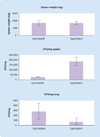Present and future therapeutic strategies for melioidosis and glanders
- PMID: 20192686
- PMCID: PMC2856610
- DOI: 10.1586/eri.10.4
Present and future therapeutic strategies for melioidosis and glanders
Abstract
Burkholderia pseudomallei and Burkholderia mallei are the causative agents of melioidosis and glanders, respectively. Both Gram-negative pathogens are endemic in many parts of the world. Although natural acquisition of these pathogens is rare in the majority of countries, these bacteria have recently gained much interest because of their potential as bioterrorism agents. In modern times, their potential destructive impact on public health has escalated owing to the ability of these pathogens to cause opportunistic infections in diabetic and perhaps otherwise immunocompromised people, two growing populations worldwide. For both pathogens, severe infection in humans carries a high mortality rate, both species are recalcitrant to antibiotic therapy - B. pseudomallei more so than B. mallei - and no licensed vaccine exists for either prophylactic or therapeutic use. The potential malicious use of these organisms has accelerated the investigation of new ways to prevent and to treat the diseases. The availability of several B. pseudomallei and B. mallei genome sequences has greatly facilitated target identification and development of new therapeutics. This review provides a compilation of literature covering studies in antimelioidosis and antiglanders antimicrobial drug discovery, with a particular focus on potential novel therapeutic approaches to combat these diseases.
Figures


Similar articles
-
Burkholderia mallei and Burkholderia pseudomallei: the causative micro-organisms of glanders and melioidosis.Recent Pat Antiinfect Drug Discov. 2007 Nov;2(3):233-41. doi: 10.2174/157489107782497335. Recent Pat Antiinfect Drug Discov. 2007. PMID: 18221181 Review.
-
[In vitro antibiotic susceptibility compliance with efficacy of chemotherapy in infections due to pathogenic Burkholderias].Antibiot Khimioter. 2009;54(7-8):19-23. Antibiot Khimioter. 2009. PMID: 20201399 Russian.
-
Comparison of efficacy of ciprofloxacin and doxycycline against experimental melioidosis and glanders.J Antimicrob Chemother. 2000 Jun;45(6):813-8. doi: 10.1093/jac/45.6.813. J Antimicrob Chemother. 2000. PMID: 10837435
-
Antibiotic susceptibility of 65 isolates of Burkholderia pseudomallei and Burkholderia mallei to 35 antimicrobial agents.J Antimicrob Chemother. 2004 Dec;54(6):1134-8. doi: 10.1093/jac/dkh471. Epub 2004 Oct 27. J Antimicrob Chemother. 2004. PMID: 15509614
-
Antibiotic resistance in Burkholderia species.Drug Resist Updat. 2016 Sep;28:82-90. doi: 10.1016/j.drup.2016.07.003. Epub 2016 Jul 30. Drug Resist Updat. 2016. PMID: 27620956 Free PMC article. Review.
Cited by
-
Burkholderia vaccines: are we moving forward?Front Cell Infect Microbiol. 2013 Feb 5;3:5. doi: 10.3389/fcimb.2013.00005. eCollection 2013. Front Cell Infect Microbiol. 2013. PMID: 23386999 Free PMC article. Review.
-
Effective Therapeutic Options for Melioidosis: Antibiotics versus Phage Therapy.Pathogens. 2022 Dec 21;12(1):11. doi: 10.3390/pathogens12010011. Pathogens. 2022. PMID: 36678359 Free PMC article. Review.
-
Melioidosis is in the Americas: A Call to Action for Diagnosing and Treating the Disease.Am J Trop Med Hyg. 2018 Sep;99(3):563-564. doi: 10.4269/ajtmh.18-0418. Epub 2018 Jul 12. Am J Trop Med Hyg. 2018. PMID: 30014822 Free PMC article.
-
Prophylactic application of CpG oligonucleotides augments the early host response and confers protection in acute melioidosis.PLoS One. 2012;7(3):e34176. doi: 10.1371/journal.pone.0034176. Epub 2012 Mar 20. PLoS One. 2012. PMID: 22448290 Free PMC article.
-
Mining host-pathogen protein interactions to characterize Burkholderia mallei infectivity mechanisms.PLoS Comput Biol. 2015 Mar 4;11(3):e1004088. doi: 10.1371/journal.pcbi.1004088. eCollection 2015 Mar. PLoS Comput Biol. 2015. PMID: 25738731 Free PMC article.
References
-
- Wiersinga WJ, van der Poll T, White NJ, Day NP, Peacock SJ. Melioidosis: insights into the pathogenicity of Burkholderia pseudomallei. Nat. Rev. Microbiol. 2006;4:272–282. - PubMed
-
-
Cheng AC, Currie BJ. Melioidosis: epidemiology, pathophysiology, and management. Clin. Microbiol. Rev. 2005;18:383–416.• A current comprehensive review about melioidosis and its clinical management.
-
-
- Currie BJ, Dance DA, Cheng AC. The global distribution of Burkholderia pseudomallei and melioidosis: an update. Trans. R. Soc. Trop. Med. Hyg. 2008;102:S1–S4. - PubMed
-
- Koponen MA, Zlock D, Palmer DL, Merlin TL. Melioidosis: forgotten, but not gone. Arch. Intern. Med. 1991;151:605–608. - PubMed
Publication types
MeSH terms
Substances
Grants and funding
LinkOut - more resources
Full Text Sources
Other Literature Sources
Medical
